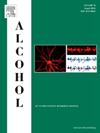The effect of developmental alcohol exposure on multisensory integration is larger in deeper cortical layers
IF 2.9
4区 医学
Q3 PHARMACOLOGY & PHARMACY
引用次数: 0
Abstract
Fetal Alcohol Spectrum Disorders (FASD) are one of the most common causes of mental disability in the world. Despite efforts to increase public awareness of the risks of drinking during pregnancy, epidemiological studies indicate a prevalence of 1–6% in all births. There is growing evidence that deficits in sensory processing may contribute to social problems observed in FASD. Multisensory (MS) integration occurs when a combination of inputs from two sensory modalities leads to enhancement or suppression of neuronal firing. MS enhancement is usually linked to processes that facilitate cognition and reaction time, whereas MS suppression has been linked to filtering unwanted sensory information. The rostral portion of the posterior parietal cortex (PPr) of the ferret is an area that shows robust visual-tactile integration and displays both MS enhancement and suppression. Recently, our lab demonstrated that ferrets exposed to alcohol during the “third trimester equivalent” of human gestation show less MS enhancement and more MS suppression in PPr than controls. Here we complement these findings by comparing in vivo electrophysiological recordings from channels located in shallow and deep cortical layers. We observed that while the effects of alcohol (less MS enhancement and more MS suppression) were found in all layers, the magnitude of these effects was more pronounced in putative layers V-VI. These findings extend our knowledge of the sensory deficits of FASD.
发育期接触酒精对多感官整合的影响在较深的皮层更大。
胎儿酒精紊乱症(FASD)是世界上最常见的精神残疾原因之一。尽管人们一直在努力提高公众对孕期饮酒风险的认识,但流行病学研究表明,在所有新生儿中,FASD 的发病率为 1-6%。越来越多的证据表明,感官处理能力的缺陷可能是导致 FASD 患者出现社会问题的原因之一。当两种感官模式的输入结合在一起时,会导致神经元发射的增强或抑制,这就是多感官(MS)整合。多感觉统合增强通常与促进认知和反应时间的过程有关,而多感觉统合抑制则与过滤不需要的感觉信息有关。雪貂后顶叶皮层(PPr)的喙部是一个显示出强大的视觉-触觉整合的区域,同时显示出 MS 增强和抑制。最近,我们的实验室证实,与对照组相比,在人类妊娠 "相当于第三孕期 "暴露于酒精的雪貂会在顶后皮层显示较少的 MS 增强和较多的 MS 抑制。在这里,我们通过比较位于皮层浅层和深层的通道的体内电生理记录,对这些发现进行了补充。我们观察到,虽然酒精的影响(较少的 MS 增强和较多的 MS 抑制)在所有层中都有发现,但这些影响的程度在推测的 V-VI 层中更为明显。这些发现扩展了我们对 FASD 感知缺陷的认识。
本文章由计算机程序翻译,如有差异,请以英文原文为准。
求助全文
约1分钟内获得全文
求助全文
来源期刊

Alcohol
医学-毒理学
CiteScore
4.60
自引率
4.30%
发文量
74
审稿时长
15.6 weeks
期刊介绍:
Alcohol is an international, peer-reviewed journal that is devoted to publishing multi-disciplinary biomedical research on all aspects of the actions or effects of alcohol on the nervous system or on other organ systems. Emphasis is given to studies into the causes and consequences of alcohol abuse and alcoholism, and biomedical aspects of diagnosis, etiology, treatment or prevention of alcohol-related health effects.
Intended for both research scientists and practicing clinicians, the journal publishes original research on the neurobiological, neurobehavioral, and pathophysiological processes associated with alcohol drinking, alcohol abuse, alcohol-seeking behavior, tolerance, dependence, withdrawal, protracted abstinence, and relapse. In addition, the journal reports studies on the effects alcohol on brain mechanisms of neuroplasticity over the life span, biological factors associated with adolescent alcohol abuse, pharmacotherapeutic strategies in the treatment of alcoholism, biological and biochemical markers of alcohol abuse and alcoholism, pathological effects of uncontrolled drinking, biomedical and molecular factors in the effects on liver, immune system, and other organ systems, and biomedical aspects of fetal alcohol spectrum disorder including mechanisms of damage, diagnosis and early detection, treatment, and prevention. Articles are published from all levels of biomedical inquiry, including the following: molecular and cellular studies of alcohol''s actions in vitro and in vivo; animal model studies of genetic, pharmacological, behavioral, developmental or pathophysiological aspects of alcohol; human studies of genetic, behavioral, cognitive, neuroimaging, or pathological aspects of alcohol drinking; clinical studies of diagnosis (including dual diagnosis), treatment, prevention, and epidemiology. The journal will publish 9 issues per year; the accepted abbreviation for Alcohol for bibliographic citation is Alcohol.
 求助内容:
求助内容: 应助结果提醒方式:
应助结果提醒方式:


